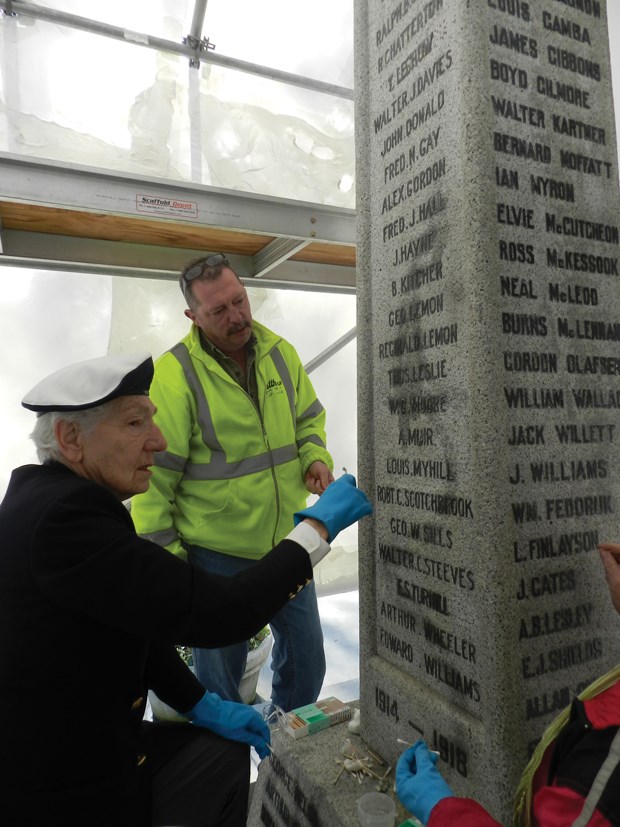After a few gentle dabs on the stained, granite surface, the acetone-soaked cotton swab in Betty Murphy's hand takes on a greyish hue.
It makes her quietly sigh with despair as she carries on with the painstaking task of removing the faint remains of black spray paint from the 92-year-old cenotaph outside Richmond City Hall.
Murphy, a member of the Vancouver Naval Veterans Association, can't fathom why anyone would target the public monument commemorating the community's war dead with graffiti.
"I don't think you can print what I'm thinking," said Murphy, 87, with a stern look in her eyes as she carries on, along with other volunteers. The cenotaph, shrouded in white plastic sheets last week to protect clean-up efforts from the tale end of winter, was one of several sites hit with graffiti, stretching from the middle arm dyke to city hall and down to Steveston.
WHILE such a cluster of incidents is unusual in Richmond, the problem of graffiti, like in most urban areas, is an ongoing battle for civic officials and property owners alike.
It's one that Sgt. Wendy Hawthorne, a graffiti expert with the Transit Police, has overseen across Metro Vancouver for the past 30 years.
Graffiti tends to create an atmosphere of lawlessness, Hawthorne said.
It's a big part of the "broken window" theory that heralds the break down of the community, she added. The concern is the behaviour then snowballs and becomes too large a problem to effectively control.
It's a situation the City of Richmond spent $7,806 in 2012 to address, and a further $8,586 last year for graffiti clean-up of city owned sites - those figures don't include road signs or local parks.
"Graffiti begets graffiti," Hawthorne said.
"If people see graffiti and it's left for long periods, others will come and do it, too, to get recognized. That's why we have bylaws and programs to get it off as quick as possible."
See more on why graffiti happens
City crews in Richmond try to remove all traces of graffiti on city property within 24 hours.
The City of Richmond, however, gives property owners who have been hit two weeks to clean things up.
If the they don't comply, the city can then perform the work and bill the owners.
It's a scenario that's not preferred, said Const. Baljinder Kandola, the Richmond RCMP's graffiti investigator, who believes that outcome only victimizes the victims.
"What we need is the graffiti coming down," she said. "The longer it's up there, the notoriety of whoever did it, builds."
A MAJOR tool to eradicate graffiti is a relatively simple one - limiting the attention it draws - said Greg Jenion, who teaches crime prevention and community safety at Kwantlen Polytechnic University's Surrey campus. But just how to go about that effectively, requires defining which category it falls into.
"You want to be careful how you respond," Jenion said. "We all want things to get better, and the initial, knee-jerk reactions, if they are not well thought out, can cause more harm than good."
A quiet, yet effective, clean-up campaign like the one used in New York City in the 1970s and '80s is an example where efforts were consistent, but not heralded.
Jenion said subway trains - a favourite target - had graffiti removed or painted over on a daily basis until the incidents started subsiding. In that case much of the graffiti was classified as "tagging" which refers to a signature or mark, often applied repetitively across a large area.
"Envision it like a dog going around marking its territory," Jenion said.
How you deal with the culprits, when finally caught, can also vary in treating the problem. While restitution is favoured by Transit Police, a hands-on approach is not always a good idea. "Originally, you would think having them clean up their own work would be smart to do," Jenion said.
Not so, in some cases, he said, because that can provide a learning experience for graffiti artists for what surfaces are more difficult to be cleaned.



